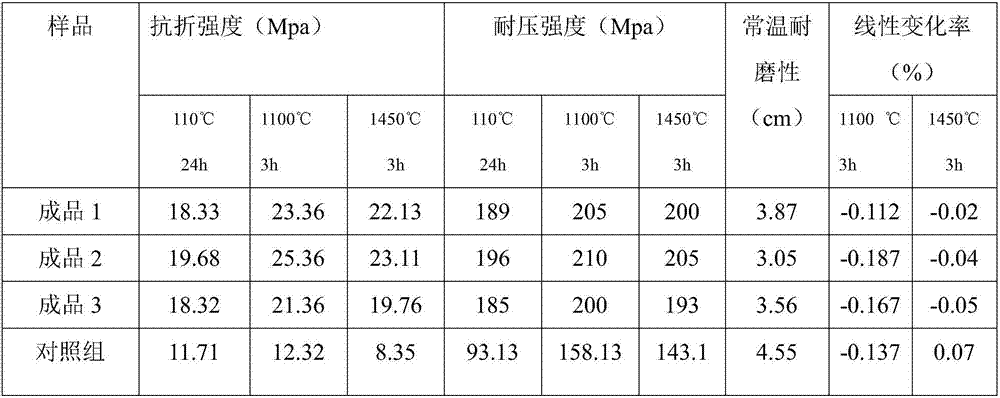Refractory wear-resistant pouring material and preparation method thereof
A fire-resistant, wear-resistant, castable technology, applied in the field of coagulation pouring, can solve problems such as poor stability, poor fluidity, difficulty in mass pouring, and low demoulding strength, so as to improve fluidity, improve mechanical strength, and reduce pretreatment The effect of the process
- Summary
- Abstract
- Description
- Claims
- Application Information
AI Technical Summary
Problems solved by technology
Method used
Image
Examples
preparation example Construction
[0044] The preparation method of the fire-resistant and wear-resistant castable, the specific steps are as follows:
[0045] Step 1. Preparation of composite glue
[0046] Take polyvinyl alcohol, water-soluble nano-scale silica sol, kaolin, vinyltriethoxysilane, boron fiber powder, and retarder in an appropriate mass ratio and mix uniformly to prepare a composite glue;
[0047] Step 2. Prepare mixed matrix slurry
[0048] Take finely ground natural river sand, alumina micropowder, microsilica fume, microsteel fiber and dispersant solution in appropriate mass ratio and particle size, and mix them uniformly to form a slurry, which has the fluidity that can be cast in the mold;
[0049] Step 3. Preparation of refractory and wear-resistant castable
[0050] Add the composite glue prepared in step 1 with an appropriate mass ratio to the graded ceramic particles with an appropriate mass ratio, and the composite glue forms a gel around the particles, followed by vacuum filtration a...
Embodiment example 1
[0052] Step 1. Preparation of composite glue
[0053]Get polyvinyl alcohol (35%), water-soluble nano-scale silica sol (44.8%), kaolin (12%), vinyltriethoxysilane (0.2%), boron fiber powder (8%), The retarder (organic acid retarder 0.001%) is mixed evenly to prepare the composite glue;
[0054] Step 2. Prepare mixed matrix slurry
[0055] Take the finely ground natural river sand (15%, 5 μm), alumina micropowder (10%, 5 μm), microsilica fume (15%, 1 μm), microsteel fiber (15%, 0.1mm) and Dispersant solution (45%, 15% sodium citrate solution), mixed evenly to form a slurry, has a fluidity that can be poured in a mold;
[0056] Step 3. Preparation of refractory and wear-resistant castable
[0057] Step 1 of adding an appropriate mass ratio to the graded ceramic particles (8-5mm: 5-3mm: 3-1mm: 1-0mm=35%: 25%: 35%: 5%) using a mass ratio (65%) Prepared composite glue (15%), the composite glue forms a gel around the particles, then vacuum filtration and drying, the gel combines ...
Embodiment example 2
[0059] Step 1. Preparation of composite glue
[0060] Get polyvinyl alcohol (20%) of appropriate mass ratio, water-soluble nano-scale silica sol (55%), kaolin (20%), vinyltriethoxysilane (0.8%), boron fiber powder (4.2%), The retarder (organic acid retarder 0.001%) is mixed evenly to prepare the composite glue;
[0061] Step 2. Prepare mixed matrix slurry
[0062] Finely ground natural river sand (20%, 10 μm), alumina micropowder (12%, 8 μm), microsilica fume (20%, 1 μm), microsteel fiber (18%, 0.1mm) and Dispersant solution (40%, 15% sodium citrate solution), mixed evenly to form a slurry, has a fluidity that can be poured in a mold;
[0063] Step 3. Preparation of refractory and wear-resistant castable
[0064] Step 1 of adding an appropriate mass ratio to the graded ceramic particles (8-5mm: 5-3mm: 3-1mm: 1-0mm=40%: 30%: 20%: 10%) using a mass ratio (60%) Prepared composite glue (12%), the composite glue forms a gel around the particles, then vacuum filtration and dryin...
PUM
 Login to View More
Login to View More Abstract
Description
Claims
Application Information
 Login to View More
Login to View More - R&D
- Intellectual Property
- Life Sciences
- Materials
- Tech Scout
- Unparalleled Data Quality
- Higher Quality Content
- 60% Fewer Hallucinations
Browse by: Latest US Patents, China's latest patents, Technical Efficacy Thesaurus, Application Domain, Technology Topic, Popular Technical Reports.
© 2025 PatSnap. All rights reserved.Legal|Privacy policy|Modern Slavery Act Transparency Statement|Sitemap|About US| Contact US: help@patsnap.com

